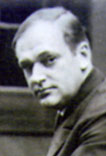 E. Paul duPont ran the Indian Motocycle Company from 1930 to 1945. He took over the reins of the struggling firm in the early part of the Great Depression, yet managed to put Indian on better financial footing by the end of the 1930s. Under his guidance, Indian set the standard for motorcycle design, introducing the popular streamlined art-deco style with the Indian Chief that many other manufacturers copy to this day. Under duPont, Indian was also the leading factory in early AMA Class C racing competition with rider Ed Kretz becoming Class C racing’s first big star.
E. Paul duPont ran the Indian Motocycle Company from 1930 to 1945. He took over the reins of the struggling firm in the early part of the Great Depression, yet managed to put Indian on better financial footing by the end of the 1930s. Under his guidance, Indian set the standard for motorcycle design, introducing the popular streamlined art-deco style with the Indian Chief that many other manufacturers copy to this day. Under duPont, Indian was also the leading factory in early AMA Class C racing competition with rider Ed Kretz becoming Class C racing’s first big star.
Eleuthere Paul duPont was born on April 24, 1887 into the renowned duPont family, which controlled an industrial empire. DuPont was interested in all things mechanical from a young age. As a teenager, he built his own engine that he mounted on a bicycle. He later owned and modified an early Indian single-cylinder motorcycle.
He studied engineering in school and by 1916 he had established a small marine engine manufacturing plant in his hometown of Wilmington, Delaware. His marine engine company evolved into a low-production automaker by the end of the 1910s. The DuPont Motors Company made luxury automobiles that were popular during the 1920s. The duPont family’s interest in Indian began as early as 1923, when E. Paul’s brother, Francis, bought $300,000 worth of stock. By the early 1930s, with the U.S. economy in serious condition, DuPont Motors merged with Indian Motocycle and ceased auto production. E. Paul duPont became the president of Indian.
Realizing that motorcycles were no longer considered basic transportation, duPont shifted Indian’s focus to leisure motorcycling and bolstered the company's image by competing on the race track. This shift, coupled with the birth of AMA Class C racing for production-based motorcycles, helped to keep the doors open during the Depression. It was also during this period that stylist Briggs Weaver, a former DuPont Motors car designer, first penned the daring new streamlined designs that were to become a hallmark of Indian style in the 1940s.
Many members of the wealthy duPont family became avid motorcyclists. E. Paul’s son, Jacques, became an AMA professional racer in the 1950s and competed a number of years in the Isle of Man TT. Another son, Steven, was a member of Indian’s engineering department and contributed to the development of the legendary Big Base Scout.
While duPont focused primarily on the business side of Indian, he also found time to consult on engineering and product design. He road tested motorcycles himself and was personally involved in the development of Indian’s 841 military model, a motorcycle that was duPont’s personal ride for many years and the one he called his favorite.
By the late 1930s, duPont had improved the financial fortunes of Indian. When he took over, Indian was losing hundreds of thousands of dollars annually, but by 1939 the company was earning unprecedented profits, in part due to the military demands of the Allies at the start of World War II and the rush of domestic buyers anticipating the scaling back of civilian production during a time of war. While the turnaround was good for Indian, it also made the company more attractive for a possible buyout.
By the mid-1940s, duPont’s health was failing and he felt he could no longer manage the day-to-day operations of a large manufacturing company. He and the Indian board of directors began entertaining offers to buy Indian. In 1945, a group headed by Ralph Rogers purchased a controlling interest of the company. On November 1, 1945, duPont formally turned the operations of Indian over to Rogers.
DuPont retired to his family estate in Delaware. He had a small machine shop on his estate so he could tinker in the evenings and still be with his wife, Jean. He passed away on September 26, 1950.
DuPont will be remembered for keeping Indian open during the darkest days of the Depression by focusing on its core business of building motorcycles. He backed the engineering department’s continued development of improved models and kept the company’s racing program vibrant under the new Class C rules. He was also an enthusiastic backer of the AMA and was involved in activities of the association.